by Susan Dean | Feb 6, 2018 | Self Science
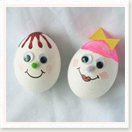
How to Blown Out an Egg
Poke two holes in it, one at either end, lengthwise. The hole for the egg contents to exit should be about a quarter of an inch in diameter. The hole you blow into can be smaller.First, poke a hole with a thick sharp sewing needle, pushing through the shell gently with very light force. You do not want to break the eggshell.
Create the second hole in the other end of the egg.
It helps to make sure you puncture the yoke before trying to blow it out.
Hold the egg over the bowl, and blow into the top hole. Be sure your grasp on the egg is not too tight or it will crack.
Once you’ve emptied the shells you need to remove egg residue from the inside.
Fill a large bowl with warm water and a few drops of dish soap.
Submerge each shell to fill it with soapy water and shake. Let sit for five minutes, then drain the water.
Empty each eggshell and rinse well.
Set aside to air dry.
You can hide the hole by gluing on small bits of tissue paper that matches your decoration.
by Susan Dean | Feb 5, 2018 | Plants, Self Science
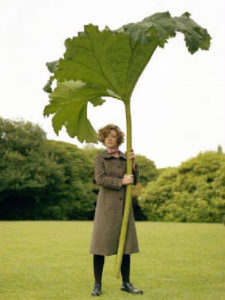 Gunnera Tinctora leaf
Gunnera Tinctora leaf
ROOTS AND LEAVES
Roots and leaves are the parts of the plant that are most important to feeding the plant. Review the song about the 6 plant parts. Where do plants get food to grow? You don’t see them in the grocery store! The leaves are like little food factories that synthesize the light of the sun into the sugar glucose. It is a process called photosynthesis. The leaf also transpires water through its leaves and breathes air through little structures on the underside of the leaf called stoma. They look like 2 lips and they open and close. Show pictures of stoma. Plants take in the carbon dioxide and put oxygen back in the air through their leaves.
The roots of a plant are important to anchor the plant and drink in water and nutrients from the soil. There are 4 basic root types: branching, tap roots, bulbs and tuber. Show kids samples of each type root and see if they can name which one it is when you hold it up.Pass out different kinds of leaves to each table for kids to examine and have them do some leaf rubbings. Point out the veins that run through the leaves that carry water and nutrients from the soil.
MATERIALS: Hand drum, chart of photosynthesis, samples of leaves, samples of root systems, picture of stoma in leaves, paper and crayons for rubbings
Activities: Sing plant songs and add ” My Roots Go Down”, leaf rubbings, grow sweet potatoe from a tuber. Let them go out with you to dig a few plants to examine their roots . . . maybe wild onion bulb, or grass, dandelion or a baby oak’s tap root. Note the arrangement of the leaves. Pick different leaves in the garden and have kids go on a leaf hunt to discover the plant in the garden that has their leaf. Grow a little duckweed in a glass of water and let them see the roots and watch them grow. Bring some root for a snack . . . maybe carrots! or radish or a little onion. Put a white carnation or queen Anne’s lace in a glass of water with a few drops of food coloring and let them observe the roots drinking up the color.
Some leaves may exibit guttation – when the leaves exude droplets of sap.
Guttation

Leaf Veins
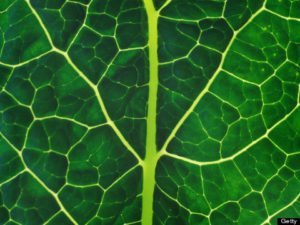
Lacinato kale
by Susan Dean | Feb 2, 2018 | Self Science

1) Styrofoam is not a marketable product. It costs lots of money to process into a usable product (the process is called densifying), and polystyrene has an extremely low market value, so our vendors cannot make money off the product (remember that recycling is a business). That is the reason we cannot accept it for recycling. You can take your styrofoam egg cartons, meat trays, and cups to Publix for recycling, but I cannot give you any information on how they are able to process the materials in a cost-effective manner.
2) We cannot accept grocery bags or any type of plastic film in the City’s blue bins or at the County’s recycling centers because the plastic film causes problems with the vendor’s machinery during the sorting process; the film wraps around conveyor belts, and machinery must be shut down for prolonged periods so the bags can be fished out. It can only be processed in a certain way, which is why grocery stores can accept that type of material, but we cannot.
3) Spartanburg County operates 17 staffed recycling centers that are open from 7 AM until 7 PM, Monday through Saturday with the Landfill site closing at 4:30 PM; this is more staffed centers with more open hours than any other County! We cannot offer curbside recycling for the 290,000 Spartanburg County residents, so we have offered multiple sites throughout the County to make recycling as convenient as possible. If you’d like to find out about which private curbside vendors offer recycling, please call us!
4) Alkaline or “regular” batteries may be taken to the Battery Post on Union St. or to Batteries Plus on Blackstock Rd. Fluorescent bulbs may be taken to Lowe’s or Home Depot. You can also bring these items to the County’s Annual Household Hazardous Waste Collection Event (March 28, 2015). The County cannot accept these materials at our recycling centers, simply because it is extremely expensive to recycle them.
5) We cannot accept some items for recycling at all of our sites simply because the centers are too small to accept those items. We strive to make recycling convenient for all residents, while still maintaining an efficient process with a limited staff and a limited budget.
6) We can accept any type of plastic that is labeled with a recycling symbol with a number 1-7 with the exception of styrofoam and plastic film (i.e. grocery bags). If your plastic does not have a recycling symbol, or the symbol does not have a number, you can throw it away with regular household trash. If you experience any confusion about a particular item, please call the recycling coordinator directly at 949-1658.
Other issues we can easily clear up:
-We accept antifreeze, motor oil, oil filters, and lead-acid batteries for recycling at all 17 of our staffed recycling centers.
-We accept paint at all 17 of our recycling centers.
-Motor oil bottles ARE recyclable.
-Mixed paper & cardboard can be recycled together at all locations (we’re working on getting better signage).
-Cell phones can be recycled with electronics.
-Steel cans (vegetable, soup, tuna, cat food, etc.) CAN be recycled with our commingled items.
-If we are closed for the holidays, our staff will not be in the office, but please leave a voicemail because we can (and do) return calls even when we’re not in the office!
Please call us at 949-1658 or email jsdao@spartanburgcounty.org if you have a specific question, if you need something that confuses you cleared up, if you’d like a copy of our brochure, if you’d like to schedule a recycling education program for your school, church group, club, etc., if you’d like to know which recycling center is closest to you, if you’d like to schedule a tour of the Wellford Landfill, or if you’d like to hear our recycling coordinator give you a very long list of all the great reasons to recycle.
by Susan Dean | Feb 2, 2018 | Self Science

Basic Floor Cleaner
Works well on all floor types – sealed wood, tile, laminate and linoleum – for regular cleaning.
Mix equal parts of white vinegar and hot water, and mop. There’s no need to rinse, and the vinegar smell dissipates once the floors have dried. The vinegar is a mild disinfectant and leaves a nice shine.
Wood Floor Cleaner and Polish
1 gallon of hot water
3/4 cup of olive oil
1/2 cup lemon juice
The hot water and lemon clean the floor, and the olive oil leaves wood floors with a nice, natural sheen. Apply it with a mop that you’ve wrung out fairly well; let it dry on its own. No need to rinse. Once dry, floors look great!
Disinfecting Floor Cleaner
For bathroom and areas of that need disinfecting.
1 gallon of hot water
1/4 cup of Borax
Mix water and Borax in a mop bucket. Borax is a great disinfectant! You don’t need to rinse.
Clean Your Towels – Stinky towels aren’t a result of using too much detergent and fabric softener. More isn’t better and over time soap residue accumulates in the fibers of towels and not only do they fail to absorb water as they can but they don’t dry like they should. When towels get a funky smell immediately upon getting wet again, failure to dry completely thanks to soap residue is usually the culprit. Run towels through the wash 2 times in hot water. DO NOT use detergent or fabric softener. In the first load use one cup of vinegar and in the second load use one cup of baking soda. The goal is to strip the softener and detergent residue from the fiber of the towel.
Clean silver – Clean ALL of your silver at ONCE! Line your sink (or pan) with aluminum foil, shiny side up. Pour 1/2 c. baking soda 1/2 c. salt into the sink. Fill sink two-thirds full with almost-boiling water. Submerge silver for about 2 minutes. Rinse with hot water, and then immediately dry with a soft cloth – Good as new!
Naturally Renew Wood – With Vinegar and Canola Oil.
3/4 cup of canola oil
1/4 cup vinegar (white or apple cider vinegar)
Mix together in a jar and rub into the wood.
You don’t need to wipe it off; the wood soaks it in.
A Check for Toxins in the Home
Dryer Sheets – The substance used to soften clothes is often derived from animal fats. The fragrances used can be toxic. Use dryer balls and essential oils for a fresh laundry smell.
Bleach-based Cleaners are highly corrosive to the skin and lungs. Mixed with ammonia (found in urine), it creates a deadly gas. When mixed with wastewater, it forms carcinogenic compounds. Use white vinegar and baking soda for disinfecting.
Oven Cleaners are full of toxins that release butane (a neurotoxin) when you spray them. Switch to a paste made from baking soda and water, and line the bottom of the oven with foil to make clean ups easier.
Carpets are treated with toxic chemicals, from flame-retardants to stain repellents. Bare wood or tile floors are best. Natural-fiber carpets can make a big difference.
Scented Candles – Commercial candles contain tiny metal wires in the wicks that can release lead into the air. Most fragrances contain plasticizers and solvents that shouldn’t be inhaled. Even beeswax and soy candles release hydrocarbons into the air, which can cause respiratory problems. Experts suggest limiting candle burning to special occasions.
Art Supplies – Dry-erase markers top the list for toxicity because they usually contain xylene, a neurotoxin.
Particleboard usually contains formaldehyde glues that give off toxic fumes. Upholstered furniture made with polyurethane foam can contain brominated and chlorinated flame-retardants that give off toxic vapors. Your best choice is solid wood furniture.
Pressure-Treated Wood has preservatives forced into it under high pressure that help repel insects and prevent rot. The chemicals used can be very toxic. Look for wood that’s been treated with the less-toxic borate preservatives.
Fertilizers and Pesticides can be very harmful to pets and children, who are the ones most likely to be rolling around in the grass. Use organic lawn treatments.
HYDROGEN PEROXIDE
USES FOR VINEGAR
SALT SAVERS
BENEFICIAL BAKING SODA
HOUSEHOLD USES FOR LEMONS
GREEN CLEANING RECIPES
GREEN CLEANING PRODUCT INFORMATION
GREEN-UP YOUR MEDICINE CABINET

Spring Cleaning Household Helps
Clean Washing Machine – Pour some vinegar into the drawer for washing powder, and set it to a wash. When finished, the washing machine will sparkle. Add 1/3 vinegar to amount of washing powder to boost cleaning power.
Clean Bathtub – Heat some vinegar in the microwave (warm). Mix vinegar with a soapy solution in a spray bottle (ratio of 1:1). Gently stir the substances together. Spray on the bathtub; leave for 30 minutes, and wipe it away with a sponge.
Cleaning the Microwave – Place half a lemon in a cup and add some cinnamon. Place the cup in the microwave for 5-10 minutes at the lowest power setting. This will help clean and disinfect, and the cinnamon will help rid unpleasant odors.
Wipe Away Dust – Apply a few drops of oil to a paper towel, and wipe across dusty areas. Then wipe again with a clean paper towel. A thin layer will be left on the surface, which helps to keep the dust from accumulating and gives the furniture an attractive sheen.
HERBY SOFT SCRUB
½ cup baking soda
½ cup Castile soap
15 drops antimicrobial essential oil
Mix ingredients in a 12-ounce glass jar until you have a nice consistency like cake frosting. If you have leftovers, add 1 teaspoon of vegetable glycerin to keep the blend nice and moist. Put a lid on the glass jar between uses.
ANTIBACTERIAL SOAP SPRAY – Use to disinfect your bathroom.
Mix ingredients together in a 16-ounce spray bottle.
14 ounces water or rosemary hydrosol
3 Tablespoons castile soap
15 drops tea tree oil
15 drops oregano oil
REFRESHING LINEN SPRAY – Refresh the mattress, pillows, bed linens, couches, and fabric-covered chairs, or spritz clean winter blankets before storing them for the year. It makes a wonderful ironing spray! Mix all of the ingredients together in a 16-ounce spray bottle.
3 ounces unflavored vodka
12 drops lavender, ylang ylang, or other essential oil
12 ounces organic hydrosol of your choice
LEMONY WOOD-FLOOR MOP FORMULA
½ cup distilled white vinegar
1 teaspoon vegetable glycerin
20 drops lemon essential oil
Water
Mix all the ingredients in a 20-ounce spray bottle.
MOP-IT-UP FORMULA – Liquid cleaner for tile floors, vinyl, or linoleum.
¼ cup castile soap
½ cup distilled white vinegar
20 drops tea tree essential oil
20 drops sweet orange essential oil
Mix solution with 2 gallons of hot water and mop away dirt and grime.
WINDOW CLEANER
Mix 4 tablespoons vinegar and 12 drops lemon essential oil in a 22- to 32-ounce spray bottle. Fill with water, and spray dirty windows. Wipe dry with well-crumpled newspapers for extra shine.
TUB SCRUB –Mix 1cup baking soda, 24 drops tea tree essential oil, and 24 drops grapefruit essential oil. Rinse tub, sprinkle powder over the surface, and scrub with a brush. Rinse well.
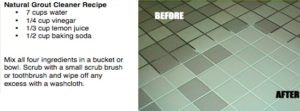
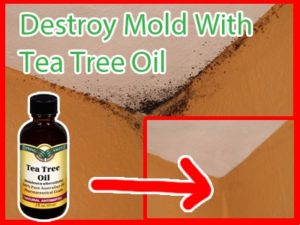
Destroy Mold
Pure Tea Tree Oil
An Open Window (Where Possible)
Sponge, Cloth and towel
Toothbrush
Scrub brush
The first step to eliminating mold is to prevent it from growing in the first place. If your room has a fan, use it. If it doesn’t, open a window in the bathroom, or open the bathroom door to keep air moving. This is very important and a very effective way to prevent the growth of mold. Mix 2 teaspoons of tea tree oil with two cups of water and add it to a spray bottle. If you’re using this in the bathroom, spray surfaces regularly. To actively remove mold, spray the solution directly to the mold and leave for an hour before using a scrub brush to remove the debris. A toothbrush can be used to reach those fine areas. Spray your chosen green cleaner on affected areas and let sit for several minutes up to an hour. Using a scrub brush or a sponge, wipe down the walls of the shower. You might need to put a little elbow grease into it, but don’t resort to bleach, which only temporarily makes the mold disappear. Toothbrushes work great on the mold joints. Spring Cleaning Recipe for the Grout 7 cups water, 1/2 cup baking soda, 1/3 cup lemon juice and 1/4 cup vinegar – throw in a spray bottle and spray your floor, let it sit for a minute or two… then scrub. LIGHT YOUR FIRE – Use dried orange peels instead of newspaper to start a fire. Orange oil is flammable and lights easily making it an excellent fire starter. Burning orange peels in your wood burning fireplace is supposed to remove any creosote that’s inside your chimney. Orange Peel Cleaner – Put orange peels in a quart jar cover with vinegar and let sit for 10 days or so. Strain out the liquid and use as all-purpose cleaner. Easy, cheap, natural and smells good.
Powdered Laundry Detergent
(3 cups = 40 loads)
1 Fels-Naptha Soap Bar, Ivory, or Dr. Bronner’s Bars
1 c. Arm & Hammer Super Washing Soda
1 c. 20 Mule Team Borax Grate bar of soap or put it in a food processor until powdered.
Combine the three ingredients in a large container. For a small load use 1 tablespoon. For heavy or very dirty laundry, use 2-3 tablespoons. Liquid Laundry Detergent (2 gallons = 64 loads) 1/3 bar of Soap 1/2 c. Arm & Hammer Super Washing Soda 1/2 c. 20 Mule Team Borax Grate bar of soap and put it in a large pot with 6 cups water. Pour in washing soda and borax and stir until completely dissolved. Remove from heat and stir in 2 more cups of hot water. Pour into a container and add an additional 1.5 gallons of water. Allow the soap to sit and gel for 1 day. Shake well and use 1/2 c. per load of laundry. Depending on what you choose, the cost is between 1 and 5¢ per load! STORE BOUGHT DETERGENT prices ranges from 4¢-20¢ per load with coupons & sales.

Floor Cleaners and Polishes Try polishing with baking soda to make them sparkle. Wash away grease spots and dull, greasy film on no-wax linoleum floors with a solution of 1/2 cup of white vinegar and 1/2 gallon of water. The floor will look sparking clean. Clean linoleum, with a damp-mop and a solution of a mild detergent and water for everyday cleaning. Keep water away from seams and edges to prevent loosening of the tiles. To preserve the floor, add a capful of baby oil to the mop water. For brick or stone floors, mix 1 cup of white vinegar in 1 gallon of water. Scrub floor with a brush and vinegar solution, then rinse. For ceramic tile floors, mix 1/4 cup of white vinegar into 1 gallon of water. This solution removes most dirt without scrubbing. Soap doesn’t work well if you have hard water.
Carpet Cleaners
Blood: Sponge the stain immediately with cold water or club soda, and dry it with a towel. Repeat as necessary.
Ink: Soak ink stains in lemon juice.
Muddy footprints: Sprinkle salt on the mud and let it dry before vacuuming.
Urine: Dab the area with a towel, wash it with suds of liquid hand-dishwashing detergent, and rinse it with 1/2 cup of vinegar diluted in 1 quart of warm water. Lay towels over the spot and weigh it down to absorb excess moisture. Let it sit for 6 to 8 hours; then remove the toweling, brush up the nap, and let the carpet dry completely.
Soot: Sprinkle the area generously with salt. Allow the salt to settle for 15 minutes or more before vacuuming.
Furniture Polish
Mix 2 parts vegetable or olive oil and 1 part lemon juice. Apply and polish with a soft cloth. Leaves furniture looking and smelling good.
Glass and Window Cleaners
½ cup vinegar to 1 gallon of water (or 2 tablespoons per quart)
½ cup ammonia to 1 gallon of water (or 2 tablespoons per quart)
To clean cut glass, sprinkle baking soda on a damp rag and clean the glass. Rinse and then polish with a soft cloth.
Remove stains on glass by rubbing them with toothpaste. Polish with a soft cloth.
Grease Removers
For grease on kitchen floors, immediately pour salt on the spot to absorb the grease and prevent staining.
If you spill grease on a wood floor, place ice cubes or very cold water on the spot. Grease will harden and can be carefully scraped off. Finally, iron a piece of cloth or folded paper towel over the grease spot to soak up any remaining grease.
All-Purpose Cleaners Mix together vinegar and salt for a good surface cleaning.
Dissolve 4 tablespoons of baking soda in 1 quart of warm water for a general cleaner or use baking soda on a damp sponge. Baking soda will clean and deodorize all kitchen and bathroom surfaces.
Drain Cleaners and Openers
To avoid clogged drains, use a drain strainer to trap food particles and hair, and collect grease in cans rather than pouring it down the drain.
Weekly, pour a kettle of boiling water down the drain to melt fat that may be building up, or pour some vinegar and baking soda down the drain to break down fat and keep your drain smelling fresh.
To open a drain, pour 1/2 cup of baking soda down the drain. Add 1/2 cup of white vinegar and cover the drain if possible. Let it sit for a few minutes, then pour a kettle of boiling water down the drain to flush it.
Another way to open a drain is to pour 1/2 cup of salt and 1/2 cup of baking soda down the drain. Follow this with 6 cups of boiling water. Let it sit overnight and then flush it with water. The hot water wil help dissolve the clog, and the baking soda and salt serve as an abrasive to break through the clog.
7 Green Hacks For Cleaning Up Old Silver
Silver expert Jeffrey Herman notes that those chemical dips work by dissolving the tarnish on an object at an accelerated rate, and they take the silver along with it. They quickly remove factory-applied patinas if left in for even more than a few seconds, or they will eventually if dipped in very quickly each time the item requires cleaning. They strip the shine from silver too, leaving it with a dull, lifeless appearance, and can also cause pitting in the surface. Herman adds that those dips are often made of a strongly suspected carcinogen known as acidified thiourea, which is a corrosive that will damage silver. A green cleaning method for making old silver shine is a much better idea.
1. Aluminum Foil
This aluminum foil solution is like a magic cleaning wand that makes tarnish disappear right before your eyes.
Aluminum foil
Aluminum or glass baking dish
1 cup boiling water
1 tbsp baking soda
1 tbsp sea salt
1/2 cup white vinegar
Soft cloth for polishing
Tongs to remove silverware from the boiling water
Bring cup of water to a boil in a pot on the stove. When the water is mixed with the other ingredients, it will activate the baking soda to start the process of transferring tarnish to the foil. Add your dry ingredients to a pot and then slowly pour in the vinegar with caution, as it will result in a slight reaction. While vinegar isn’t an absolutely necessary ingredient in the process, it will help speed it up significantly. Pour the boiling water in after the vinegar. Place silver into the pot so each piece is touching the foil. Pieces should all be spaced apart slightly. Leave them in for 30 seconds, or a few minutes if the pieces are heavily tarnished. Using tongs remove the silver and rub off remaining spots by buffing with the soft cloth.
2. Ketchup can actually clean tarnished silver. Add a little bit to a paper towel and then gently rub it over tarnished areas of the silver. For tough objects you may need to allow the ketchup to stay on them for 15 to 20 minutes and then rub the tarnish off with a soft cloth. For objects that have textured details like fancy silverware, use a toothbrush to get into those hard to reach areas.
3. Baking soda – Completely cover tarnished pieces in baking soda using a generous amount and covering the objects until they’re totally immersed. Allow it to sit and perform its magic for about 30 minutes. Dampen a soft cloth with hot water and buff the baking soda into the piece using the cloth to rub off the tarnish. Rinse the object thoroughly in hot water.
4. Rubbing alcohol – For mild mineral spots or residue, you can mix together 4 parts water and 1 part rubbing alcohol in a bowl. Simply dip a clean, soft cloth into the mixture, and then rub it over your silver. Afterward, wipe it dry using another clean cloth.
5. Cornstarch – Mix up a paste using water and cornstarch, which works similar to baking soda. Apply the paste with a damp, soft cloth and allow it to dry. Once it’s dried, rub off the tarnished areas using cheesecloth.
6. Banana peels – Toss three banana peels into your blender and add just a little water to make a paste. Use this paste to clean the silver by dipping a toothbrush into it, and then working it around your silver. Dip the piece into water to rinse off any residue that remains.
7. Toothpaste works on silver similar to how it removes plaque from teeth. Squeeze out a bit of toothpaste onto a cloth and then use that to polish your silver. If piece is heavily tarnished, let it sit for a minute or two before polishing with your cloth. Rinse.
by Susan Dean | Feb 2, 2018 | Self Science
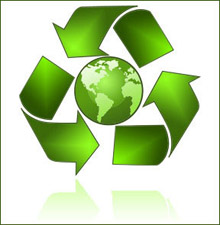
Wasteful Things We Can Live Without:
Everything Styrofoam! Stamp out styrofoamPlastic wrap — Instead, use a container with a lid.
Tin foil — Use an oven-safe pot or dish with a lid.Disposable cleaning cloths, dusters, etc. — Use a microfiber cloth that can be washed.
Paper towels — Use a tea towel, instead.
Disposable pens — Buy a good pen that only needs the ink well changed.
Paper plates — Washing dishes may be an effort, but it’s worth it.
Plastic cutlery — Use the metal stuff.
Disposable razors -Invest in a razor that only needs the blades changed.
Packaged fruits and vegetables. Produce does not need to be packaged.
Individually wrapped snacks — Snacks travel better anyway in a hard container.
Juice boxes — Put juice in a reusable container (not plastic).
Electric pencil sharpeners — Use the hand-crank version of days gone by.
Disposable diapers — Cloth diapers aren’t that much more difficult to use.
Disposable cloths — Fabric cloths can be washed regularly to avoid bacterial or viral build-up.
Paper or plastic single-use grocery bags — Get a few reusable bags.
Bottled water — Install a water filter on your tap or pick up a water jug with a filter.
Non-rechargeable batteries — Make the investment for rechargeable batteries and you’ll save money in the long run.
Electric can openers — Use a little muscle.
Single-serving pudding or yogurt cups — Buy a large container of yogurt or make your own pudding, and send it in a reusable container.
Plastic cups — Stick to reusable cups.
Disposable table cloths — Spills are a reality of life; just clean them up as they happen.
Antibacterial wipes — If you must, use a gel hand sanitizer.
Facial tissues — Unless you have a bad cold, a handkerchief will work just fine.
Paper billing — Switch to e-billing for your bank statement, credit card bill, utility bill, etc.
Plasticized sticky notes — Use the original paper sticky notes; they can be recycled when you’re done with them
by Susan Dean | Feb 2, 2018 | Self Science

The U.S. Environmental Protection Agency sampled around 2,000 rivers and streams in 2008-2009 and released a draft version of the National Rivers and Streams Assessment. What they found is pretty alarming: Only 21 percent of rivers and streams were deemed to be in “good” health, while 23 percent were rated “fair” and 55 percent got a “poor” grade.
Of the three major climatic regions (Eastern Highlands, Plains and Lowlands, and West) discussed in this report, the West is in the best biological condition, with 42% of river and stream length in good condition. In the Eastern Highlands, 17% of river and stream length is in good condition; in the Plains and Lowlands, 16% is rated in good condition.
Nutrient pollution is a major cause, with phosphorus and nitrogen running off from agricultural and urban sources. Land development can cause accelerated erosion and flooding (mostly through removing natural plant and tree cover).
Nancy Stoner, Office of Water Acting Assistant Administrator at the EPA, said:
The health of our Nation’s rivers, lakes, bays and coastal waters depends on the vast network of streams where they begin, and this new science shows that America’s streams and rivers are under significant pressure. We must continue to invest in protecting and restoring our nation’s streams and rivers as they are vital sources of our drinking water, provide many recreational opportunities, and play a critical role in the economy.
Globally, 15 million children under the age of five die each year because of diseases caused by drinking water.
In the United States, people use over 1.8 billion disposable diapers, 220 million tires, and 30 billion foam cups per year. This gives you a snapshot of why we produce so much garbage from year to year.
Over 1 million seabirds and 100,000 sea mammals are killed by pollution every year. This is in addition to the staggering, likely uncountable amount of fish killed by water pollution.
Cadmium is a common pollutant which kills human fetal sex organ cells, is in almost everything we eat and drink.
Russia’s Lake Karachay, a nuclear waste dump zone, is the most polluted place on Earth. 5 minutes near it, unprotected, can kill you.
Approximately 46% of the lakes in America are too polluted for fishing, aquatic life, or swimming.
The Mississippi River brings about 1.65 million tons of pollution into the Gulf of Mexico each year, making a dead zone the size of New Jersey.
The three most air-polluted cities in the U.S are, in order, Bakersfield, Fresno, and Riverside, all within California. China is the world’s largest carbon dioxide emitter, producing more than the U.S and Canada combined, emitting 171% more than it was in 2000.
Each person in the U.S produces about 4 lbs of garbage per day.
Polluted coastal water costs the global economy $12.8 billion a year in death and disease. The ancient Greek Acropolis is believed to have crumbled more in the last 40 years than it has in the previous 2,500 due to acid rain. FYI, Acid rain is caused by the emissions of sulfur dioxide and nitrogen oxide interacting with water molecules in the atmosphere, meaning that, essentially, modern city life causes acid rain.


 Gunnera Tinctora leaf
Gunnera Tinctora leaf








